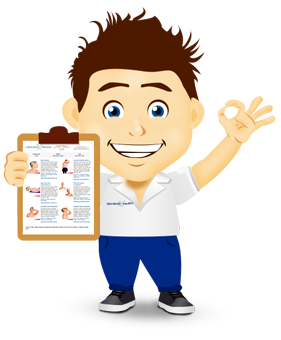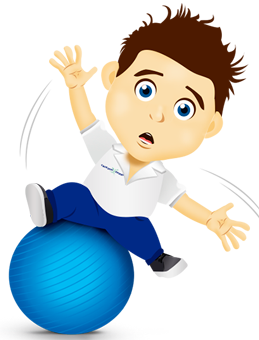
Next steps:
Feel free to read the advice sheet below! To get the full benefit click on 'Start treatment'. By starting the treatment you will get access to weekly rehab programmes online for FREE. You will be able to track your progress, pain levels and we will remind you to do your exercises every day!
Hamstring injuries are at the high incidence rate in various field sports which require powerful accelerations, deceleration or explosive movements, in every year around the world. American football, Australian rules, Soccer, rugby union, rugby league are the fields sports which have growing number of athletic population with hamstring strain. The primary objective of a rehabilitation program following a hamstring strain injury is to rehabilitate the athlete to return to sport with a good level of performance and minimal risk of injury recurrence.
Grades of hamstring strain:
There are three levels of hamstring strain.
Grade1 : Mild muscle strain.
Grade2: Partial muscle strain.
Grade3: Complete muscle strain.
Time span for rehabilitation and return to play may differ depending upon the nature and severity of strain.
Grade 1 injury : Hamstring should be rested from sporting activity for approximately 3 weeks. Even if the athlete with Grade 1 injury would feel better and would like to return to play, he /she would be usually advised to undergo rehabilitation program to avoid further injury.
Grade 2 injury : Grade 2 injury requires a minimum period of 4 to 8 weeks for recovery.
Grade 3 injury : Complete rupture which has to be surgically repaired and rehabilitation to follow for approximately 3 months. a
Rehabilitation and treatment protocols for hamstring injuries:
Acute phase: (1 to 5 days)
Initial management of RICE protocol ( Rest, Ice, Compression and Elevation ) has been done immediately following hamstring strain to minimize further tissue damage , bleeding ,to settle down the acute inflammatory reaction and to control pain. Non steroidal anti-inflammatory drugs ( NSAIDS) may be given during the initial days following the muscle injury ( no sooner than 2-3 days).Once pain subsides, retrograde massage can be started.
Sub acute phase: (Day 5 - 3weeks)
- Stretching ( 3- 4 times per day )
- Deep Tissue massage (Daily)
- Strengthening exercises ( Daily)
- Pain free sub maximal isometric exercises are encouraged.
- Isometric knee flexion, stool, scoots seated hamstring curls can be performed
- Athlete should be given cardiovascular fitness and training (up to 2 sessions / day).
- Exercises are initiated to develop neuromuscular control of trunk and pelvis.
- Isometrics of the limb pelvic musculature.
- Single -limb balance exercises.
- Short stride frontal plane stepping drills.
Remodeling phase: (1-6 weeks)
- Stretching progression: progress to frequent stretching(advanced).
- Strengthening progression
- Progress to concentric strengthening.
- Standing hamstring curls.
- Prone hamstring curls ( Including eccentric component)
- Manual prone concentric / eccentric hamstring curls.
- Prone leg dropping.
- Hamstring ball rolls.
- Progress to concentric strengthening.
Once concentric strengthening has been performed with ease then begins eccentric strengthening.. Hamstring strain often occurs during an eccentric contraction of the muscle when the athlete is involved in sports activity. As a result these injuries can create further weakness at the lengthened state of muscle, predisposing the athlete to chronic injury. Lengthened state eccentric training which is believed to increase the end range strength of hamstring muscle should be incorporated in the rehabilitation protocol to reduce the chance of recurrence.
Eccentric training can be achieved using an isokinetic dynamometer if available and performing exercises like
- Nordic hamstring curl (Norwegian hamstring exercise )
- Lengthened state eccentric training on biodex and cable column
- Single leg eccentric hamstring windmills which may be performed without weights at the beginner level and can be progressed to hand-held weights.
Functional phase ( 2 weeks to 6 months )
When an athlete can perform a brisk walk for about 30 minutes without pain or any discomfort, then jogging can be initiated at very low intensity which could be further progressed to running and finally sprinting.
End phase of rehabilitation
Plyometrics can be used to strengthen the hamstring muscle group and to improve the neuromuscular properties which is needed to perform specific sport activities effectively and efficiently in the later stage of rehabilitation. Marching, jogging, toe jogging are some of the plyometrics warm up exercises.
Plyometrics exercises includes: The program below is just a guide and should be tailored to individual patient needs and progressed according to their level of performance.
- Cycle split jump
- Running butt kicks
- Pogo jumps with knees to butt.
- Roller board hamstring pulls.
- Leg swings
- Heel toss with med ball.
- Box step jumps and depth jumps.
- Forward depth jumps in series
- Forward hurdle hops
Return to sport (3 weeks to 6 months)
After the rehabilitation process, it is highly important to assess the strength and flexibility of the injured muscle before returning to sports to ensure that no residual deficit are present which can cause chronic injury.
Injection therapy:
Epidural steroid injection is used to treat hamstring injuries, according to the recent study. When it is injected to the sacral region it reduces the sensitivity of the nerves thereby helping the muscle group to return to a normal resting tone. Thus it has been suggested that ESI used in conjunction with other local therapies, play a useful role in prevention and treatment of hamstring injuries.
According to American Journal Of Sports Medicine, Cortical steroid injections has been recommended for Grade IIB hamstring injuries in athletes.
These injections may provide a faster recovery , helping the athlete to return to play and potentially decrease the risk of subsequent injury. Copper cited published work by William N. Levine, M.D, found that Dexamethasone and Lidocaine injections in National Football League (NFL) players who sustain Grade IIB lesions decreased the average return to play to 6.3 day with no cases of infection or re-injury. Copper said, "I think that injection is great for II B injuries and it is safe. It speeds recovery and it may even reduce the re-injury rates".
References:
- Daniel Lorenz ,Michael Reiman , the role and implementation of eccentric training in athletic rehabilitation: tendinopathy,hamstring strains and ACL reconstruction, International Journal of sports physical therapy, Int J Sports phys ther.2011 March ;6(1):27-44
- Bryan c. Heiderscheit, Marc a. Sherry, Amy Silder, Darryl G. Thelen, Hamstring Strain Injuries: Recommendations for Diagnosis, Rehabilitation and Injury Prevention, National Institute of Health, Madison. J Ortho Sports Phys Ther. 2010 February ; 40(2): 67–81.
- Preventative exercise progression for hamstring strain, Hamstring Rehabilitation and Prevention Protocol university of Delaware Sports and Orthopedic clinic.
- UW Health Sports Medicine Physician group, Marc Sherry ,Rehabilitation Guidelines Following Proximal Hamstring Primary Repair, University of Wisconsin Sports Medicine, March,2011
- Hamstring Strain Treatment & Management
Author: Jeffrey M Heftler, MD; May 17,2013
- Dr J Wilson, Dr. Peter T Myers, Hamstring Injuries, Brisbane Orthopaedic and sports Medicine Clinic
- William N.Levine,John Bergfeld , William Tessendorf ,Claude T. Moorman, Intramuscular Corticosteroid Injection for Hamstring Injuries- A 13 Year experience in National Football League, The American journal of Sports medicine, Am J Sports Med May 2000,vol28,297-300(pub med)
- Karoly Szalai ,Arpad Illyes, Sacral Epidural Steroid Injections Used For The Prevention of Hamstring Injuries , Scientific paper, Facta Universitatis , series :physical education and sports, Vol 3,2005,pp 37-44
- X –ray guided steroid injections effectively treat Hamstring tendonitis, American College Of Radiology, Study suggest , Science Daily,6 May 2010
- Marc A. Sherry,Thomas M. Best, Journal of Orthopaedic and sports Physical Therapy, A Comparison of 2 rehabilitation Programs in the acute Hamstring strains, J Orthopaedic sports phys ther ,vol 34,March 2004

